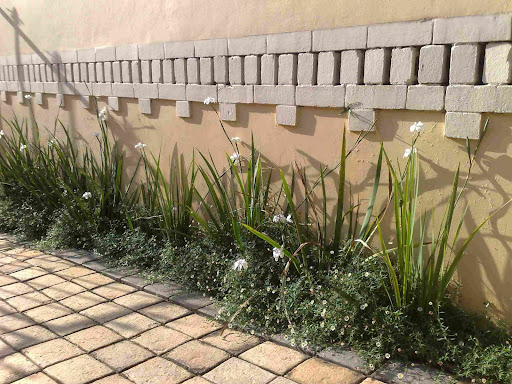Recently, I went back to visit a garden that I completed about 9 months ago. This garden was a little tricky, in that it was a smallish garden with multiple uses. There were 3 main areas to the garden - a front garden with a pool and high walls, an old concrete driveway, and a grassy back garden with a patio area.




Before Photos
There were a couple of good points, that I felt we could use. There were some existing Eugenia hedges that would do a great job of breaking the height of the walls, but they were being cut too short to really make any impact. A medium-sized Leopard tree stood in the corner, which looked great, but possibly gave too much shade for the amount of traffic that the grass was subjected to. Also, there were some beautiful Icebergs growing around the edges of the grass.
The brief revolved mainly around updating the driveway, and improving the garden in general. The limiting factors were the need for parking and keeping an area for turning vehicles that come out of the garage.
I did some initial sketches with a couple of options to choose from, but my client was justifiably worried about losing too much space for parking and turning the cars. We settled on a comfortable balance between parking and aesthetics.
I kept the planting simple, using at the most 3-4 types of plants to an area, and removing the unwanted plants. I decided to keep the Eugenia hedge as a backdrop, with Duranta "Sheena's Gold" as a lower hedge in front, and then either Felicia, Agapanthus, or Plectranthus in the front.


We replaced the concrete on the driveway with Huguenot cobbles from Smartstone, and then planted Dietes grandiflora with Erigeron in between.
On the blank wall to the side, we attached wire to the wall and planted Trachelospermum (Star Jasmine) to climb up to form diamond shapes. This will make the wall seem less stark, and at the same time, spread the scent of Jasmine into the garden.
The brief revolved mainly around updating the driveway, and improving the garden in general. The limiting factors were the need for parking and keeping an area for turning vehicles that come out of the garage.
I did some initial sketches with a couple of options to choose from, but my client was justifiably worried about losing too much space for parking and turning the cars. We settled on a comfortable balance between parking and aesthetics.
I kept the planting simple, using at the most 3-4 types of plants to an area, and removing the unwanted plants. I decided to keep the Eugenia hedge as a backdrop, with Duranta "Sheena's Gold" as a lower hedge in front, and then either Felicia, Agapanthus, or Plectranthus in the front.


We replaced the concrete on the driveway with Huguenot cobbles from Smartstone, and then planted Dietes grandiflora with Erigeron in between.

The triangle bed between the driveway and patio, was previously a blank grass area. This left the patio area exposed. We moved some of the roses from the shadier north part of the garden into this bed, and then planted Lavender at the back, with Erigeron in front. The wire that can be seen in front of the bed, was to keep Bella the boisterous rottweiler out of the new flower beds. It gives a minor shock when you touch it (I've tested it!). After a couple of times of being shocked, the animals stay out of the bed. At this point you can turn it off, and even remove it, and the animals still won't go back into the beds.
We installed an irrigation system throughout the garden. In the main grassy area, we used pop-ups. In the rest of the beds and along the driveway, because of their awkward shape, we used drip irrigation pipes. This would also keep evaporation to a minimum, and therefore save water. The drawback with these pipes seems to have been their tendency to come apart at the joins, unless the hose clamps are extremely tight.
We installed an irrigation system throughout the garden. In the main grassy area, we used pop-ups. In the rest of the beds and along the driveway, because of their awkward shape, we used drip irrigation pipes. This would also keep evaporation to a minimum, and therefore save water. The drawback with these pipes seems to have been their tendency to come apart at the joins, unless the hose clamps are extremely tight.


Nearly a year after planting, I am very happy with the growth. Unfortunately, a caterpillar seems to have gotten into some of the Agapanthus, and eaten them. The hedges still need to fill out a bit, but are looking quite healthy. The drip pipe gives the odd bit of trouble, when the pressure is high. I'm looking forward to visiting this garden 2 years from now, when everything is more fully grown.





No comments:
Post a Comment